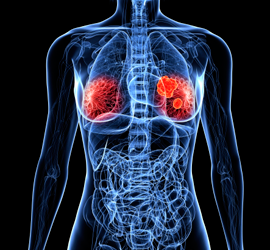Neoadjuvant Chemotherapy Reduces ctDNA Tumor Fraction in TNBC
Findings suggest that sensitive circulating tumor DNA analysis may be a valuable tool for guiding neoadjuvant treatment decision-making in early-stage triple-negative breast cancer.
"These data suggest that sensitive ctDNA analysis in the neoadjuvant setting may be a valuable tool to guide treatment in the neoadjuvant setting for [early-stage] TNBC," according to the study authors.

Treatment with neoadjuvant chemotherapy yielded reductions in circulating tumor DNA (ctDNA) tumor fractions that often dropped below the detection level of a commercially available assay, suggesting a need for more sensitive tests to enable treatment tailoring, according to findings from an exploratory analysis of the phase 2 TBCRC 030 trial (NCT01982448).
All patients (n = 38; 100%) were positive for ctDNA at baseline with a median tumor fraction of 3.1x10–3 (range, 2.2x10–6 to 4.9x10–1). At 3 and 12 weeks after beginning treatment, respectively, 79% and 55% of patients were positive for ctDNA. Investigators highlighted a 285-fold decrease in tumor fraction at week 3 among 19 patients with a response. Additionally, 19 matched non-responders experienced a 24-fold decrease in tumor fraction at the same period.
Investigators reported ctDNA clearance in 10 of 11 patients with a residual cancer burden (RCB) of 0 at week 12, as well as 3 of 8 patients with RCB 1, 4 of 15 with RCB 2, and 0 of 4 with RCB 3.
Of 8 patients with known disease recurrence, 5 of 6 with plasma samples collected at week 12 had persistent ctDNA and a median tumor fraction of 4.0x10–3 (range, 2.0x10–5 to 7.9x10–2). Additionally, 1 patient with no persistent ctDNA at week 12 only had 1 detectable mutation, suggesting that the tumor fraction may have fallen below the assay’s detection limit of 1.5x10–5.
Of 8 patients without known recurrence, 5 of 7 with collected plasma samples experienced ctDNA clearance. All 8 patients without recurrence had a RCB of 0; of those with recurrence, 2 had RCB 1, 2 had RCB 2, and 4 had RCB 3.
“For [over half] of patients, [tumor fraction] had dropped below the limit of detection [LOD] reported in currently available conventional assays, underscoring the need for more sensitive approaches in this setting to enable treatment tailoring,” the study authors wrote. “These data suggest that sensitive ctDNA analysis in the neoadjuvant setting may be a valuable tool to guide treatment in the neoadjuvant setting for [early-stage] TNBC.”
The prospective, open-label, randomized phase 2 TBCRC 030 trial evaluated neoadjuvant cisplatin vs paclitaxel as a treatment for patients with TNBC. Investigators of the exploratory analysis assessed ctDNA dynamics in responders—patients with RCB 0/1—and non-responders—those with RCB 2/3.
Patients were randomly assigned 1:1 to receive 75 mg/m2 of cisplatin every 3 weeks for 4 cycles or 80 mg/m2 of paclitaxel every week for 12 weeks.
Investigators used the MAESTRO assay to track up to 1000 patient-specific tumor mutations in cell-free DNA. Plasma samples were collected at baseline and at 3 and 12 weeks after treatment initiation.
Patients with invasive TNBC or estrogen receptor–low breast cancer that was clinical stage I with a tumor at least 1.5 cm in size or stage II to III were eligible to enroll on the trial. Those with a known germline BRCA1/2 mutation were not able to enroll.
Investigators conducted personalized MAESTRO assays to target a median of 1000 genome-wide somatic mutations per patient, which were applied to a total of 114 plasma samples from week 0 to 12. Each patient had a median of 633 mutations (range, 269-686) as detected by the MAESTRO assay and a personalized minimal residual disease tracker assay.
Reference
Parsons HA, Blewett T, Chu X, et al. Circulating tumor DNA association with residual cancer burden after neoadjuvant chemotherapy in triple-negative breast cancer in TBCRC 030. Ann Oncol. Published online August 18, 2023. doi:10.1016/j.annonc.2023.08.004